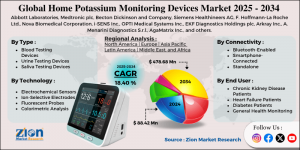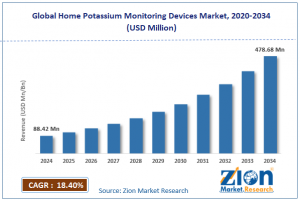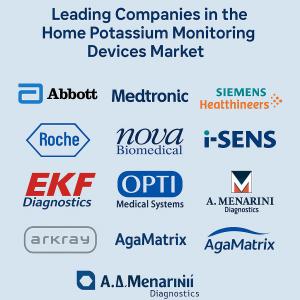Home Potassium Monitoring Devices Market to Surge to $478.68 Million by 2034, Expanding at 18.40% CAGR
global home potassium monitoring devices market was valued at approximately USD 88.42 million in 2024 and is expected to reach around USD 478.68 million by 2034
The global home potassium monitoring devices market is experiencing exponential growth, driven by the rising prevalence of chronic kidney disease, cardiovascular conditions, and an increasing shift toward personalized and remote patient monitoring. Valued at USD 88.42 million in 2024, the market is forecasted to surge to approximately USD 478.68 million by 2034, expanding at a CAGR of 18.40% from 2025 to 2034.
Elevate your business strategy with comprehensive market data. Request a sample report now: https://www.zionmarketresearch.com/sample/home-potassium-monitoring-devices-market
These devices, enabling real-time potassium level checks at home, are becoming essential tools in preventive care, especially for patients at risk of hyperkalemia or hypokalemia. The market is supported by technological innovations, rising healthcare costs, and a global push toward decentralized healthcare models.
Key Insights:
As per the analysis shared by our research analyst, the global home potassium monitoring devices market is estimated to grow annually at a CAGR of around 18.40% over the forecast period (2025-2034)
In terms of revenue, the global home potassium monitoring devices market size was valued at around USD 88.42 million in 2024 and is projected to reach USD 478.68 million by 2034.
The home potassium monitoring devices market is projected to grow significantly due to increasing healthcare spending, rising awareness of electrolyte imbalances, and growing integration of AI in diagnostic devices.
Based on type, blood testing devices lead the segment and will continue to lead the global market.
Based on the technology, ion-selective electrodes lead the market with the largest revenue share.
Based on connectivity, smartphone-connected devices are anticipated to command the largest market share.
Based on the end-user, chronic kidney disease patients represent the predominant market segment during the forecast period.
Based on region, North America is projected to lead the global market during the forecast period.
Do You Have Any Query Or Specific Requirement? Request Customization of Report: https://www.zionmarketresearch.com/custom/9520
Market Dynamics:
✅ Market Drivers:
Rising Prevalence of Chronic Diseases: Conditions like kidney disorders, heart failure, and diabetes often require regular electrolyte monitoring.
Aging Global Population: Older adults are more prone to imbalances in serum potassium levels, increasing the demand for home-based diagnostic tools.
Remote Patient Monitoring (RPM) Adoption: Growing use of RPM and digital health tools boosts demand for portable and connected potassium monitoring devices.
Technological Advancements: Integration with smartphones, AI-powered analytics, and Bluetooth connectivity is increasing device accessibility and user-friendliness.
Healthcare DDecentralization: The Shift from hospital-based care to home-based care post-COVID-19 pandemic accelerates market growth.
❌ Market Restraints:
High Initial Device Costs: Limited affordability in low- and middle-income regions.
Regulatory Barriers: Strict approval and compliance requirements can delay market entry for new players.
Limited Awareness: Especially in emerging markets, about the importance of potassium monitoring.
Market Segmentation:
Tampa Florida based Krewe of Europa to appear in the Tarrytown NY Halloween Parade
Key Housing Announces August Featured Listing for Bakersfield Short-term Housing
Hands-On Diagnostics Announces Annual Symposium to Help Physical Therapists Improve Patient Outcomes
Więcej ważnych informacji
 Jedynka Newserii
Jedynka Newserii

 Jedynka Newserii
Jedynka Newserii

Konsument

Grupa nowych biednych emerytów stale się powiększa. Ich świadczenie jest znacznie poniżej minimalnej emerytury
Przybywa osób, które z powodu zbyt krótkiego czasu opłacania składek pobierają emeryturę niższą od minimalnej. Tak zwanych nowych biednych emerytów jest w Polsce ok. 430 tys., a zdecydowaną większość grupy stanowią kobiety – wskazują badania ekspertów Instytutu Pracy i Spraw Socjalnych. W ich przypadku krótszy okres składkowy zwykle wynika z konieczności opieki nad dziećmi lub innymi osobami w rodzinie. Wśród innych powodów, wymienianych zarówno przez panie, jak i panów, są także praca za granicą lub na czarno oraz zły stan zdrowia.
Media i PR
M. Wawrykiewicz (PO): Postępowanie z art. 7 przeciw Węgrom pokazało iluzoryczność tej sankcji. Unia wywiera naciski poprzez negocjacje nowego budżetu

Przykład Węgier pokazał, że procedura z artykułu 7 traktatu o UE o łamanie praworządności nie ma mocy prawnej z powodu braku większości, nie mówiąc o jednomyślności wśród pozostałych państw członkowskich. Negocjacje nowego budżetu UE to dobry pretekst do zmiany sposobu części finansowania z pominięciem rządu centralnego. Czerwcowy marsz Pride w Budapeszcie pokazał, że część społeczeństwa, głównie stolica, jest przeciwna rządom Viktora Orbána, ale i na prowincji świadomość konsekwencji działań Fideszu staje się coraz większa przed przyszłorocznymi wyborami.
Firma
Blockchain zmienia rynek pracy i edukacji. Poszukiwane są osoby posiadające wiedzę z różnych dziedzin

Zapotrzebowanie na specjalistów od technologii blockchain dynamicznie rośnie – nie tylko w obszarze IT, ale również w administracji, finansach czy logistyce. Coraz więcej uczelni wprowadza programy związane z rozproszonymi rejestrami, które wyposażają studentów w umiejętności odpowiadające wymogom rynku.
Partner serwisu
Szkolenia

Akademia Newserii
Akademia Newserii to projekt, w ramach którego najlepsi polscy dziennikarze biznesowi, giełdowi oraz lifestylowi, a także szkoleniowcy z wieloletnim doświadczeniem dzielą się swoją wiedzą nt. pracy z mediami.




![Nestlé w Polsce podsumowuje wpływ na krajową gospodarkę. Firma wygenerowała 0,6 proc. polskiego PKB [DEPESZA]](https://www.newseria.pl/files/1097841585/fabryka-nesquik_1,w_85,r_png,_small.png)






.gif)

 |
| |
| |
|